As an e-commerce business owner or brand manager in Australia, understanding your target audience’s cultural considerations and consumer behavior is crucial for success.
This article will explore Australian e-commerce shoppers’ demographics, online shopping behavior, and key factors influencing their purchase decisions.
By delving into these insights, you will gain actionable statistics to effectively cater to the unique preferences of Australian consumers and amplify your e-commerce success in the local market.
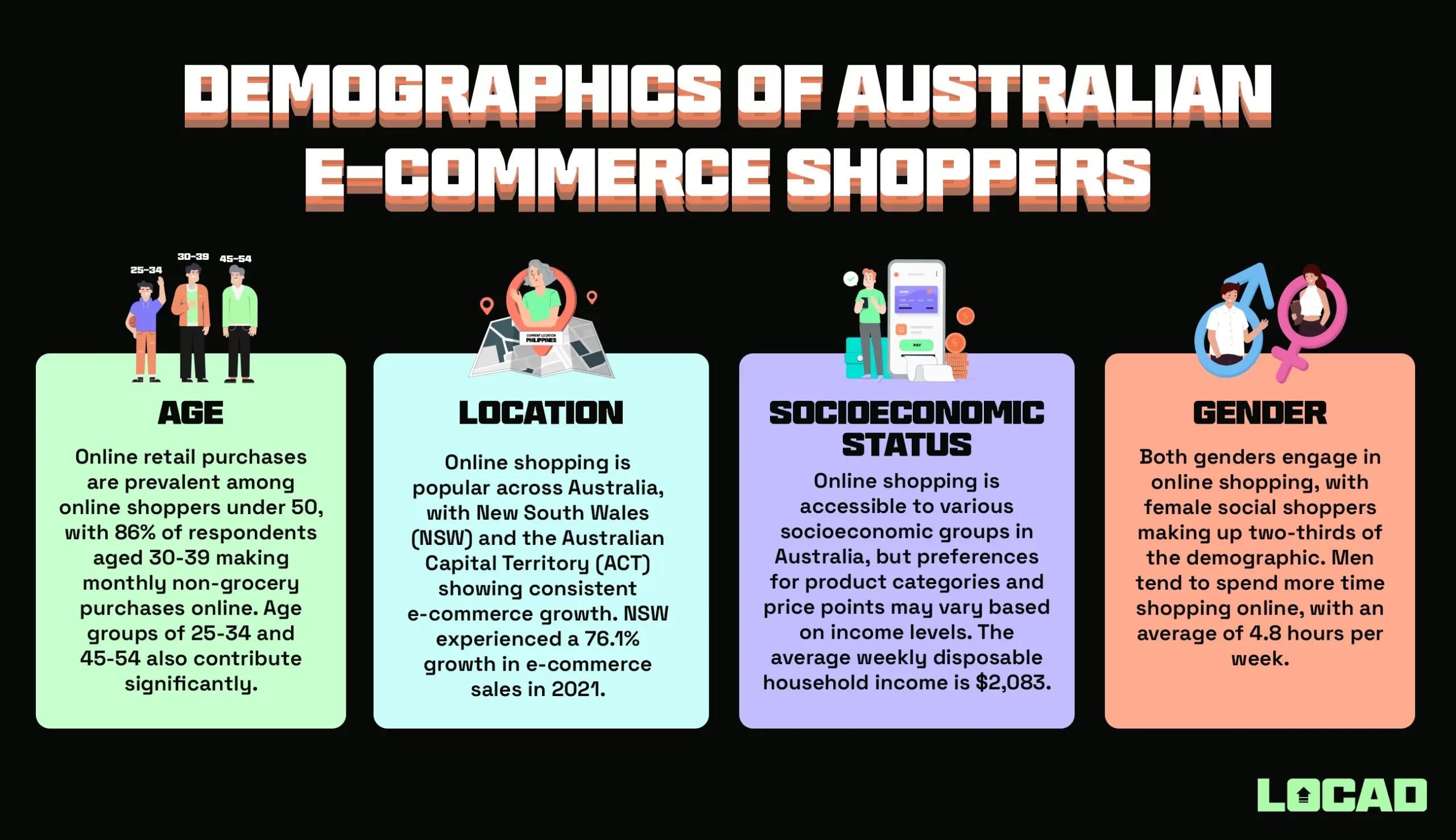
Demographics of Australian E-commerce Shoppers
To effectively cater to Australian consumers, it’s essential to have a clear understanding of their demographics. Let’s explore some key demographic factors that influence their online shopping behavior:
- Age: According to an August 2022 survey in Australia, online retail purchases were more prevalent among online shoppers under 50, with 86% of respondents aged 30-39 purchasing non-grocery products online every month. A 2018 Contevo research showed that Aussies aged 35–44 contributed 24% to all internet sales. Other significant age groups buying online were 25 to 34 year olds and 45 to 54 year olds who participated with over 20% each.
- Location: Online shopping is prevalent across Australia, but preferences may vary slightly based on location. A 2022 Australian online shopping survey reported that New South Wales (NSW) and the Australian Capital Territory (ACT) consistently recorded the highest e-commerce growth since 2019. NSW saw a 76.1% growth in 2021 for e-commerce sales and a 14.1% increase in YOY growth in purchases.
- Socioeconomic Status: Online shopping is accessible across various socioeconomic groups in Australia. However, preferences for certain product categories and price points may differ based on income levels and spending power. The average equivalised disposable household income was $2,083 per week.
- Gender: Online shopping is popular among both genders in Australia. According to a survey conducted in July 2020 among online consumers in Australia, just under two-thirds of social shoppers were female. Around one-third of consumers shopping through social media networks were male. Another survey found that men spend more time online shopping than women, with men spending an average of 4.8 hours per week browsing the sales, compared to 4.1 hours for women.
Understanding these demographics can help you tailor your product offerings, marketing strategies, and user experience to cater effectively to your target audience.
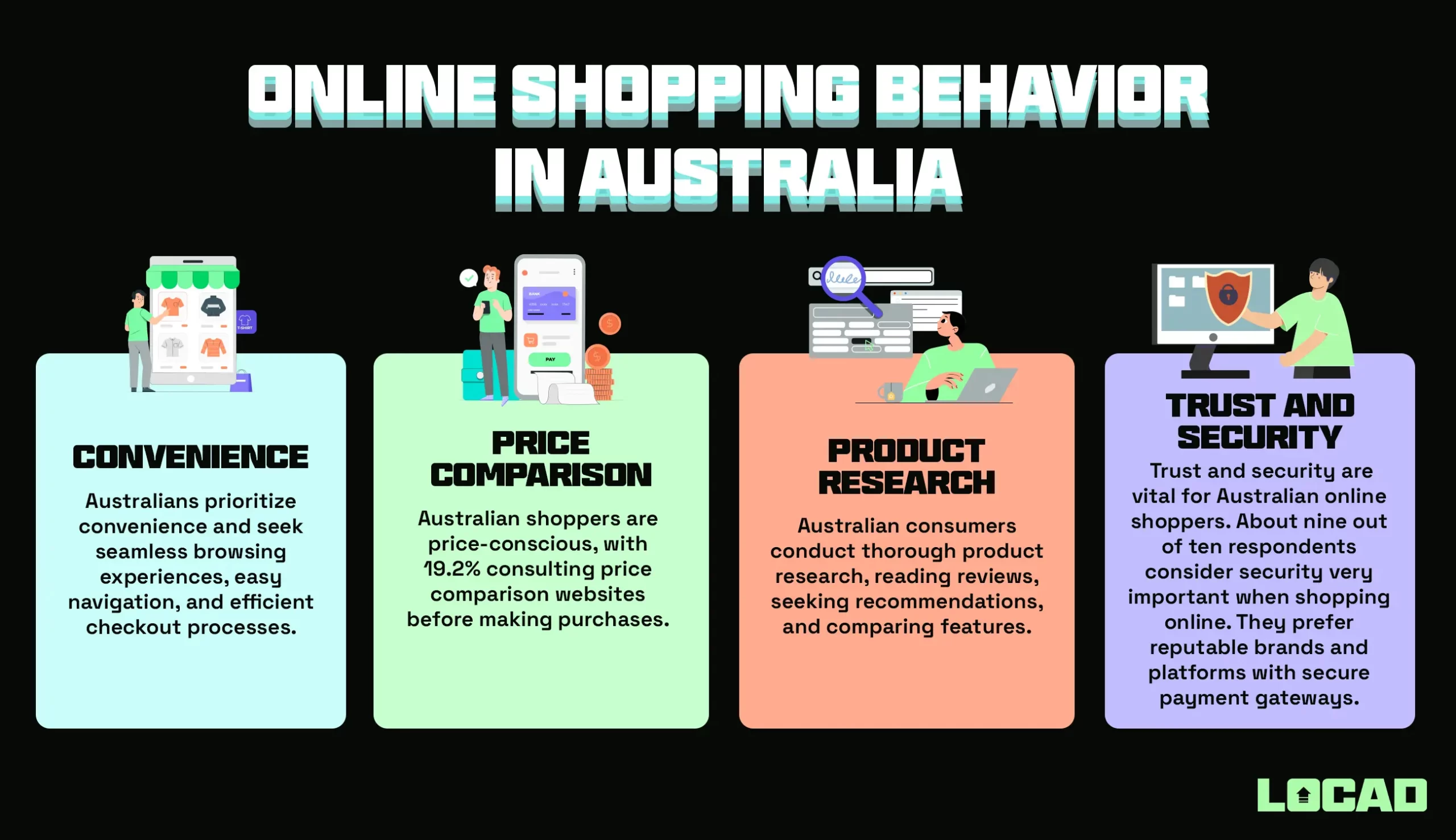
Online Shopping Behavior in Australia
Our general observation shows that Australian consumers exhibit certain online shopping behaviors that shape their preferences and expectations. Here are some key aspects to consider:
- Convenience: Australians value convenience and time-saving solutions. They appreciate seamless browsing experiences, easy navigation, and efficient checkout processes. Optimizing your website’s user interface and ensuring smooth functionality can enhance their shopping experience.
- Price Comparison: Australian shoppers are known for their price-consciousness. A 2022 study by Hootsuite and We Are Social about Australia’s e-commerce landscape showed that 19.2% of customers consulted a price comparison website before making a purchase.
- Product Research: Before making a purchase, Australian consumers conduct thorough product research. They read reviews, seek recommendations, and compare features. Providing detailed product information, customer reviews, and ratings can instill confidence in their decision-making process.
- Trust and Security: Trust and security are paramount for Australian online shoppers. In a survey conducted by Statista, about nine out of ten respondents in Australia considered security very important when shopping online. They prefer to shop from reputable brands and platforms with secure payment gateways. Displaying trust symbols, ensuring secure transactions, and highlighting your commitment to data privacy can help build trust with your audience.
By aligning your e-commerce strategies with these online shopping behaviors, you can create a seamless and satisfying experience for Australian consumers.
Experience fulfillment by Locad today!
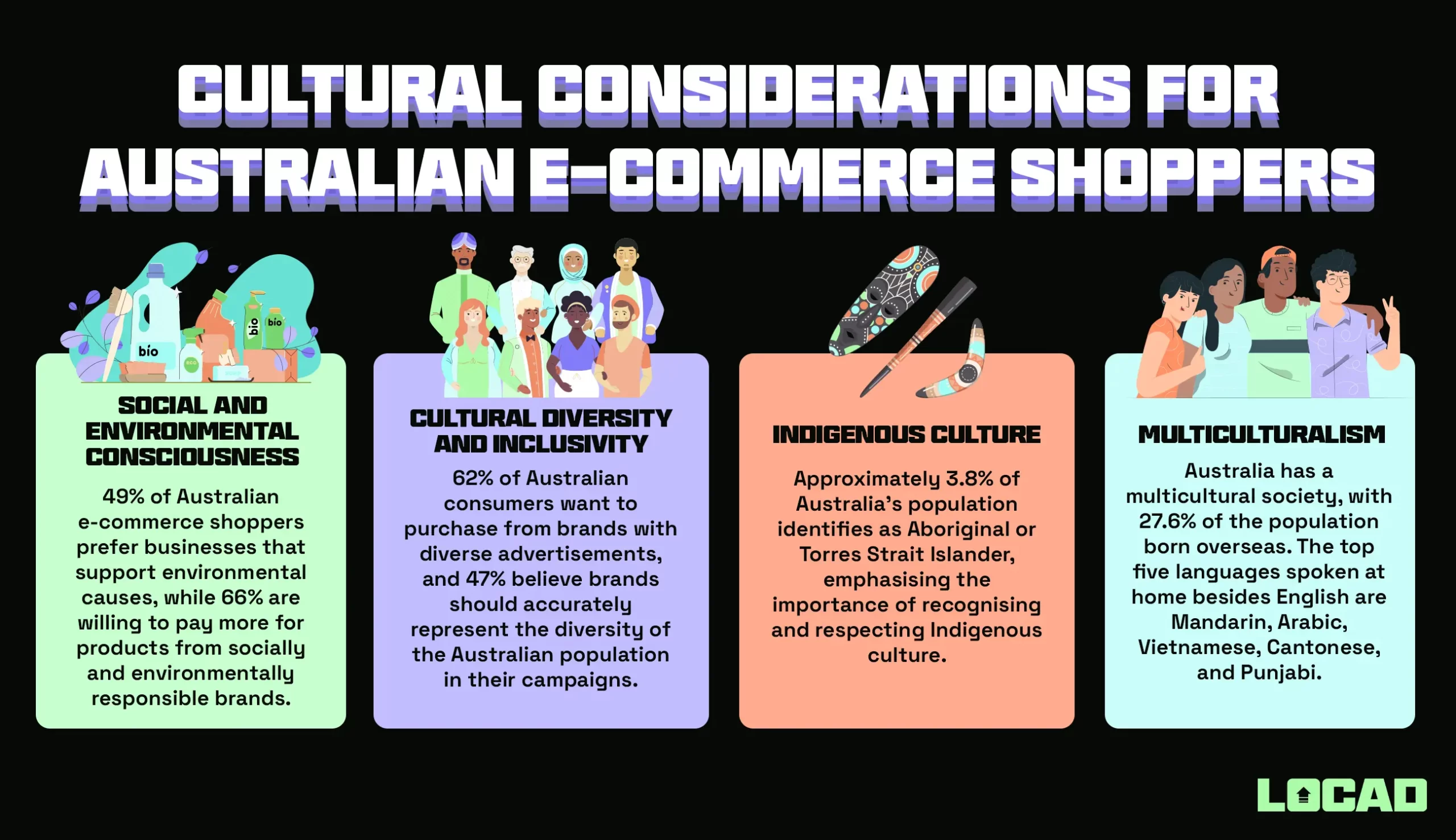
Cultural Considerations for Australian E-commerce Shoppers
Cultural considerations play a role in shaping the preferences and expectations of Australian e-commerce shoppers. Here are some findings from our observation of the Australian market:
- Social and Environmental Consciousness: A study conducted by Australia Post found that 49% of e-commerce shoppers in Australia are more likely to choose products from businesses that support environmental causes. According to a survey by Nielsen, 66% of Australians are willing to pay more for products and services from brands committed to making a positive social and environmental impact.
- Cultural Diversity and Inclusivity: Cultural diversity also leads to changes in Australian consumers’ expectations. According to Adobe’s 2019 survey, 62% of Australian consumers want to purchase from brands with diverse advertisements. The same survey found that 47% of Australians believe that brands should accurately represent the diversity of the Australian population in their advertising campaigns.
- Indigenous Culture: Recognizing and respecting Australia’s Indigenous culture is crucial. According to the Australian Bureau of Statistics, approximately 3.8% of Australia’s population identifies as Aboriginal or Torres Strait Islander.
- Multiculturalism: Australia is known for its multicultural society. According to the latest release of the Cultural Diversity: Census 2021 by the Australian Bureau of Statistics, 27.6% of the population were born overseas. The top 5 languages used at home, other than English, were Mandarin (2.7%), Arabic (1.4%), Vietnamese (1.3%), Cantonese (1.2%) and Punjabi (0.9%). The top 5 countries of birth (excluding Australia) were England, India, China (excludes SARs and Taiwan), New Zealand and the Philippines. You can find more information on this topic on the Australian Bureau of Statistics website.
By considering and incorporating these cultural factors into your e-commerce strategies, you can better resonate with Australian consumers, build trust, and establish a positive brand image that aligns with their values and expectations.
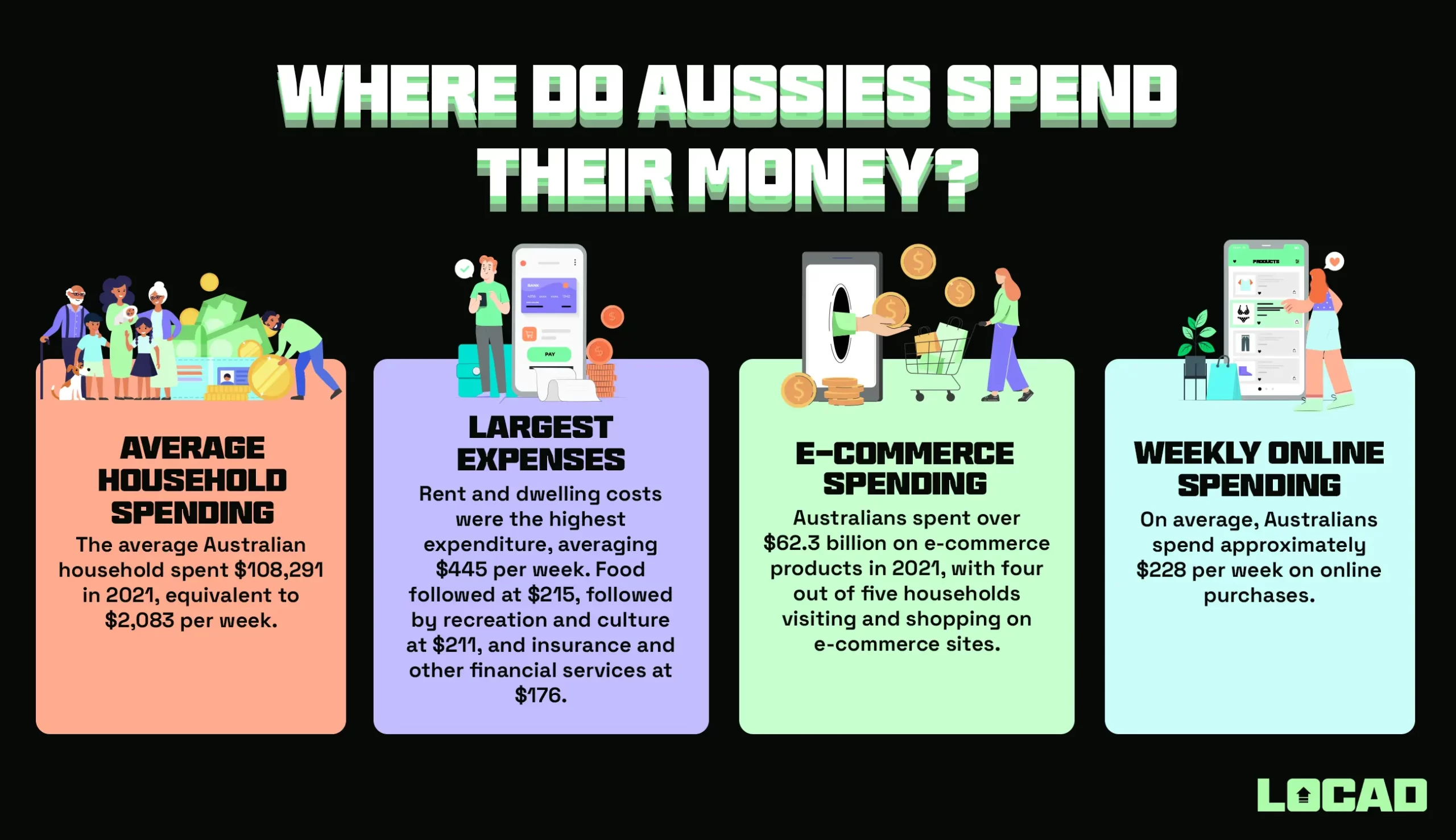
Where Do Aussies Spend Their Money?
According to the Monthly Household Spending Indicator by the Australian Bureau of Statistics, household spending increased 8.2% through the year on a current price, calendar adjusted basis. The average household spent $108,291 in 2021, equivalent to $2,083 weekly.
Rent and dwelling costs are the largest expense by far, costing the average household $445 per week. Food comes in second place ($215), followed by spending on recreation and culture ($211) and insurance and other financial services ($176).
In addition to household spending, Australians also spend a significant amount on e-commerce. According to Australia Post’s 2021 e-commerce insights, online consumers spent more than $62.3 billion on e-commerce products in 2021.
Four out of five Australian households visit and shop on e-commerce sites, increasing yearly national growth by 12.3%. In a week, the average Aussie checked out around $228 online.
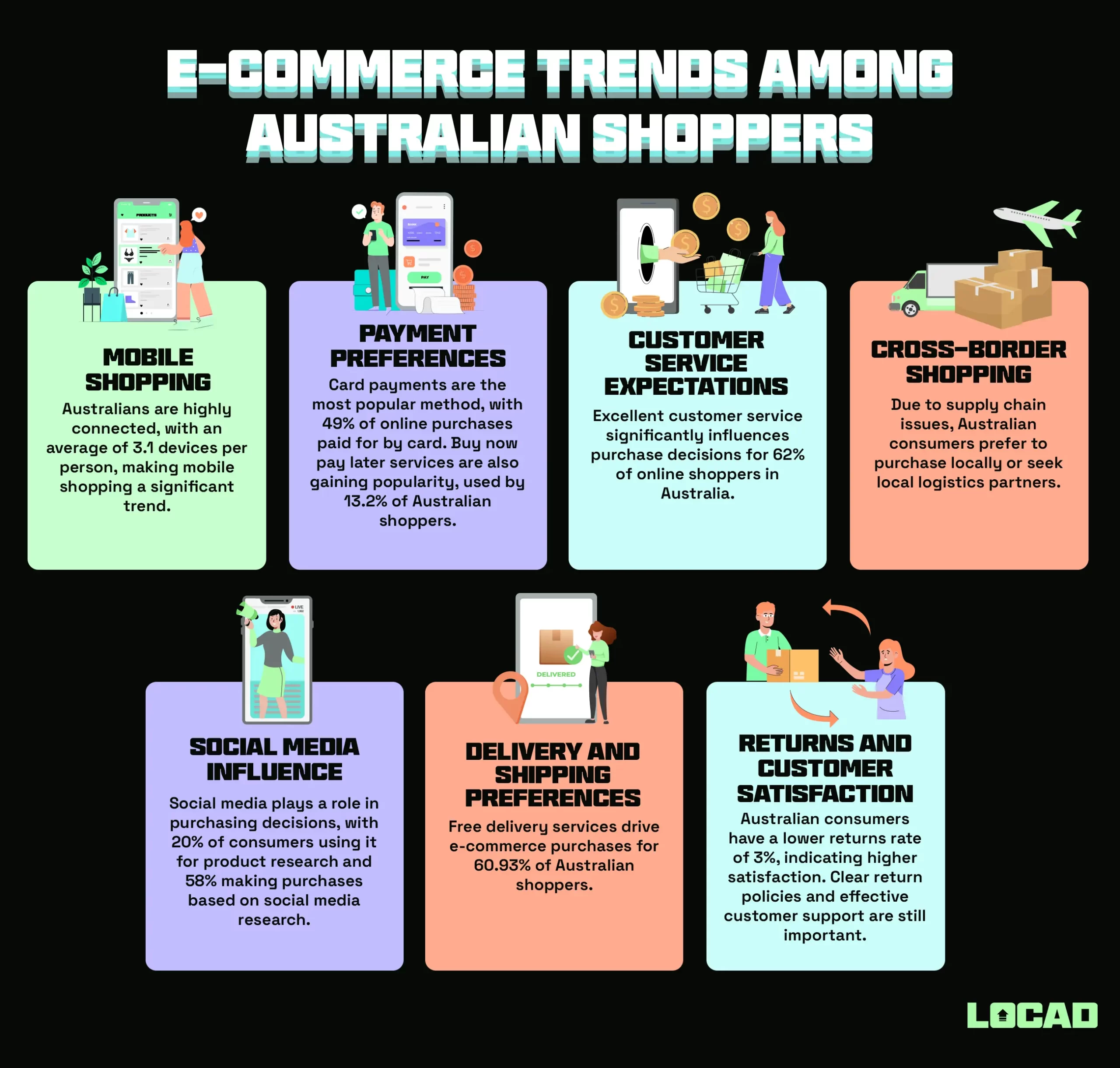
Other E-commerce Trends on Australian Shoppers
In addition to the cultural considerations and online shopping behavior of Australian consumers, several trends are shaping the preferences and expectations of Australian shoppers. Understanding them is crucial for e-commerce businesses to stay competitive and effectively cater to the Australian market. Let’s explore some of these trends:
- Mobile Shopping and Usage in Australia: Australians are highly connected, with an average of 3.1 devices per person, one of the highest rates worldwide.
- Payment Preferences of Australian Shoppers: A 2022 study by Hootsuite and We Are Social about Australia’s e-commerce landscape showed that 13.2% used a buy now pay later service for online transactions. As of 2022, almost half of all online purchases in Australia were paid for by card. In comparison, paying with cash or via bank transfer was far less popular among Australian online consumers. 9% of purchases were paid using bank transfers and just 1% with cash. Over the past year, 75% of Aussies pay using e-wallets and bank cards, while 16% prefer bank transfers.
- Customer Service Expectations: Great customer service is a primary expectation in the Australian market. 62% of online shoppers say past customer service significantly influenced their purchase decision.
- Cross-border Shopping Habits: Due to global supply chain bottlenecks and freight delays caused by reduced air travel, Australian consumers are looking to purchase locally instead of from overseas suppliers. If you are considering Australia as a destination for starting or expanding your e-commerce business, go local first. Or find a strategic logistics partner who can help you with Australia expansion.
- Social Media Influence on Australian E-commerce Shoppers: Australian shoppers are active on social media and use it to make purchasing decisions. According to Sensis, an Australia-based marketing firm, roughly 20% of consumers use social media to research products, and 58% reported that their social media research resulted in a purchase.
- Delivery and Shipping Preferences: Free Delivery services are the primary driver for e-commerce purchases among 60.93% of Australian shoppers between 16 to 64.
- Returns and Customer Satisfaction: Australian consumers have a lower than average returns rate of 3% compared to almost 6% globally. This indicates that Australian shoppers are generally satisfied with their purchases and have lower instances of returns. However, it remains important for e-commerce businesses to have clear and flexible return policies and effective customer support to address any potential issues or concerns that may arise.
By staying informed about the e-commerce trends that influence Australian shoppers, businesses can adapt their strategies to meet the evolving preferences and expectations of the local market.
Wrapping Up
Understanding Australian shoppers’ cultural considerations, online shopping behavior, and e-commerce trends is crucial for businesses’ success in the local market. By tailoring strategies to meet the preferences and expectations of Australian consumers, your business can create a seamless and satisfying online shopping experience.
By staying informed about the evolving e-commerce trends and partnering with a strategic logistics provider like Locad, you s can effectively navigate the Australian market and enhance your e-commerce success.
Connect with Locad today and unlock the full potential of your e-commerce business in Australia. With our warehousing, fulfillment, and logistics expertise, we offer tailored solutions that align with Australian shoppers’ unique preferences and expectations. Let Locad be your trusted logistics partner and take your e-commerce operations in Australia to new heights.











